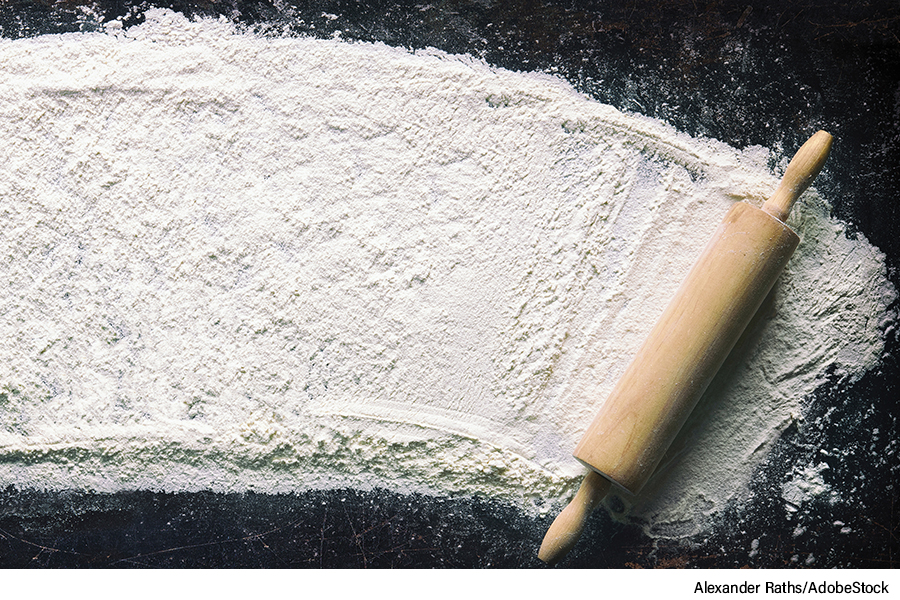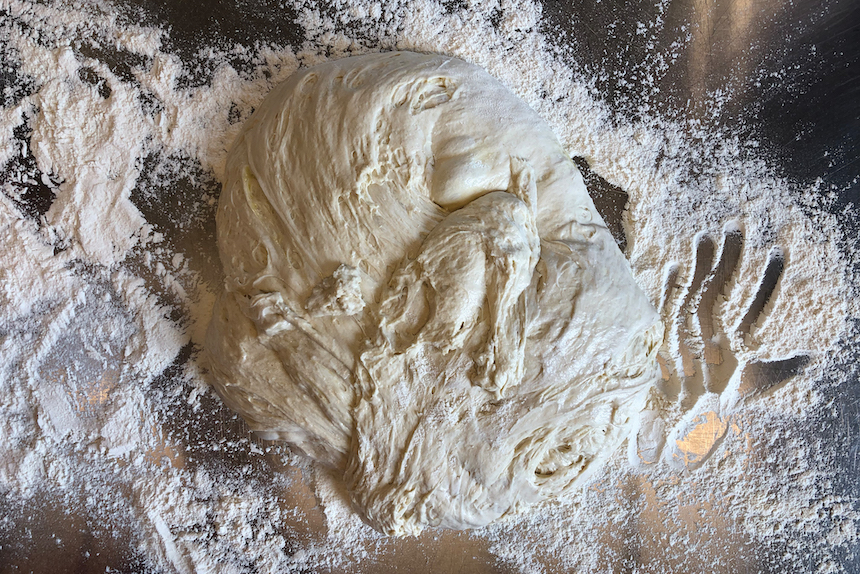Blend it like Beckham
“Today’s pizzamakers are fortunate to live in an era wielding not only a diversity of grains, but also the knowledge of nutrition, gluten strength and fermentation to harness their full potential. The Fertile Crescent has come full circle as ancient grains are blended with contemporary expertise to create these beautiful modern pizzas.”
-Serhan Ayhan, Owner, Next Level Pizza, New York
In these modern times, chefs, bakers and innovative pizza makers like Serhan Ayhan are all looking for identity-shaping foods for their businesses. Many pizza makers have shifted their focus to a more artistic strategy that was usually used by chefs in their shiny controlled kitchens. This new artistic perspective about the platform that is pizza combines structural integrity, layering of flavors, new uses of ancient grains, and a combination of grains for their pizza crusts. The new pizza artists are now pushing the limits of manipulation like fine wine makers to achieve the perfect pizza crust. The more knowledge you have of your flour, the more you will be able wrap your pizza head around the perfect crust for your pizzeria. Just remember, any negative characteristics of a certain flour can be altered by other flours to create a superstar pizza crust.
Mixed Blessings
The characteristic of flour depends on the variety, location and growing conditions. Some wheats are considered soft and some are known as hard. Hard wheat has more of the protein’s gliadin and glutenin which form gluten when the flour is moistened. While mixing doughs, there are two distinctions; strong flours — which have a high protein content and are used to make breads, pizza and other yeasted products and weak flours — which are made from soft wheat and are used to make cookies, cakes, and pastries.
Endo What?
The composition of each wheat kernel consists of bran, germ and endosperm. Let’s jump in this geeky swamp for a second.
Bran: This is the hard, outer skin of the kernel and represents 14 percent to 17 percent of the grain. It is darker in color than it appears as small brown flecks, usually named whole wheat. In cases where millers crush white wheat, or screen out the bran, they may appear lighter. Other darker flours like Spelt, Einkorn, Rouge de Bordeaux etc. are darker also. Whole wheats may be altered into more lighter, or “golden” by the miller screening more of the bran out.
Pizza Bakers Note: Because Bran flakes are sharp, they affect the strength of the gluten bubbles and negate a certain level of extensibility you seek to both stretch your dough for a better cornicione, or airy crust. Millers use the distinction extraction that refers to the total amount of bran and germ taken out as a percentage. A lower extraction means that more endosperm is in your flour and less bran and germ. This may help you formulate the rise of your pizza with other factors like heat and hydration.
Germ: This little nugget of life is what creates a new plant if the kernel is sprouting and represents 2-3 percent of the grain. The germ is the vitamin hub of the kernel containing protein, nutrients and vitamins. Germ also contains a lot of fat and therefore can become rancid quickly if held too long.
Pizza Bakers Note: Adding raw wheat germ at 5-7 percent of total flour in your pizza recipe will create a nice nutty flavor and much more nutritious bread without hindering the gluten strength.
Endosperm: This is the starchy, white interior of the kernel after the bran and germ are removed and represents 81-83 percent of the grain. Depending upon the type of kernel, it represents about 67-76 percent starch and between 6-18 percent protein. It contains small amounts of minerals, sugar, fat and moisture. Many consider this as flour once the germ and bran are removed by the millers.
Pizza Bakers Note: Because the ground endosperm represents the bulk of starch and protein, it is most important to know the aspects of each one. Starches are complex carbohydrates and can absorb up to half of their weight in water and a small amount of starch becomes available as food for yeast. About 6-18 percent of white flour is protein depending upon the variety of kernel. Roughly 80 percent of proteins are glutenin and gliadin which, when combined with water create gluten. This creates the scaffolding that supports the gluten net that holds the carbon dioxide which makes an airy pizza crust. Of course, all this depends upon many, many factors. Some high-gluten flours contain added gluten to achieve consistency- some companies call this “reinforced” flour.
A Note on Baker’s Percentage:
This practical shift from ounces and pounds provides an accurate and faster way to measure flour in your pizzeria. By taking the total flour in kilograms and grams and basing the other ingredients individually against the flour, you’ll be able to speedily mix and replicate recipes. For example, when 1000 grams of flour is used with 100 grams of water, the water baker’s percentage is 10 percent. If the salt in this same recipe is 10 grams, then the baker’s percentage of the salt is one percent.
Power of the Flour
Flour is usually categorized as high-gluten flour at 14-percent protein, bread flour at 11-13.5-percent protein, cake and pastry flour which are 8 percent and 9 percent respectively.
European flours typically top out at 11.5-percent protein, lower than typical North American flours. They are graded on ash content. T45 and T55 are flours with low ash for cake and pastry. T65 are high-gluten and higher grades are flours with increasing darkness ending at dark rye designated T170.
Some other flours that are trending in innovative pizza products are as follows:
Spelt: Often considered the ancestor of modern wheat, this grain has become increasingly popular in pizzerias. It has a lower absorption than wheat and a weaker gluten structure, so it usually needs to be ground finer and/or mixed with a high-gluten mix. I’ve used local, Amish-grown spelt at a 60-percent mix to 40 percent high gluten for almost 15 years. The payoff of using spelt is a deep, slightly sweet, molasses flavor and nutty flavor that customers love.
Kamut: This durum wheat is trending with up to 40 percent higher protein than modern wheat. This golden flour has a nuttiness with hints of butter, and it is packed with nutrients. Many flour companies are milling white Kamut flour. Kamut has a reputation as being more easily digested than regular wheat and it has a chewy texture. I like this pizza dough with strong cheeses like goat and Gruyère paired with fatty pork, sweet fruit, and nuts.
Buckwheat: First documented in China 6000 years ago, this grain is rich in zinc, copper and manganese and is an important grain for vegans. Buckwheat adds zero gluten to your pizza crust mix but packs loads of strong nutty flavor. It must be ground finely because it will dilute the structural matrix, less is more.
Kernza*: I’ve used this Perennial Wheat for almost 10 years in my menu-mix. Long known as the next wave of sustainable grains, Kernza has roots that can penetrate the earth up to 10 feet down which will produce grain even in drought conditions. This also means no tilling, no fertilizers or pesticides that are needed to grow this grain. Kernza has 17-percent protein and a sharp bran which means it needs to be screened more by the millers. The reward is a pizza crust that is a brown sugary, almost honey-like flavor of nuts and maple.
Durum: Because of climate change, this is the grain of the future because it grows in hot, arid environments. Durum is a golden flour known as semolina and has different grinds, for pasta and breads. I’ve been getting different blends from Sicily that are stone ground at Molina del Ponte. The Rimacinata flour is a blend of Simeto, Duilio and Appio durum wheats but my favorite for baking a wonderful Focaccia Barese and Pizza in Teglia is 100 percent Tumminia. The sweet nuttiness and cakelike texture of this grain makes an airy, unforgettable crust.
Einkorn: This is one of the oldest wheats that has been cultivated. Its low gluten content may drive a pizza maker nuts which is why I use it with higher gluten flour for a fluffy, velvety texture with a slight chew. The advantage is a deep nutty and almost grassy taste perfect with cream sauces and strong cheeses.
Soy and Rice: These both contain no gluten and are used extensively in non-gluten crusts. These flours are added to the trendy Roman pizza called Pinza*. The soy flour is used as a non-gluten replacement for wheat and the white rice flour gives the pizza a crunchy and soft texture. It is mixed with olive oil to cloak some of proteins that form gluten. Using too much soy flour can lead to an unpleasant beany flavor but toasted soy flour adds a pleasant taste. Too much rice flour adds a sticky and oily finish to the tongue.
John Gutekanst owns Avalanche Pizza in Athens, Ohio.








